


SAMUEL TAYLOR COLERIDGE 1772 -
(G3a, G3b, G3c, G4, W4)
xxxxxThe English poet Samuel Taylor Coleridge is best known for his dramatic, haunting Rime of the Ancient Mariner, published in Lyrical Ballads, a collection he wrote together with his fellow poet William Wordsworth in 1798. As a principal founder of the Romantic movement in English literature, this poem and his two other major works, Kubla Khan and Christabel, are rich in imagination and mystery, and venture into realms of romance, magic and, at times, the supernatural. Human emotion is given free rein, no longer restrained by the staid poetical style of the day. A man of immense intellect and wide knowledge, he also excelled in literary criticism, and was admired in particular for his observations on the works of Shakespeare and Wordsworth. His work in this connection is mostly to be found in his lectures, and in his Biographia Literaria, written in 1817. In addition to Wordsworth, he numbered among his friends the poet Robert Southey and the writers Thomas De Quincey and William Hazlitt.
Including:
Robert Southey

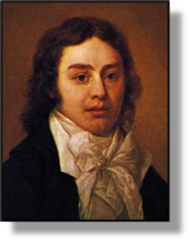
XxxxxThe poet and critic Samuel Taylor Coleridge was one of the principal founders of the Romantic Movement in English literature. His best known poem The Rime of the Ancient Mariner appeared in Lyrical Ballads, a work which he produced in collaboration with his fellow countryman and poet William Wordsworth in 1798. Some of his finest work was composed at this period, including the symbolic poem Kubla Khan, and the mystical narrative poem Christabel, and these established his reputation as a poet.
xxxxxAs befits a true romantic, Coleridge was a self-
xxxxxBut his talent went far beyond that of a poet, a genre in which his inspiration was virtually spent by the age of 30. He was a brilliant conversationalist, and his huge range of interests testify to his extraordinary intellect, as do his lectures and writings on literary criticism. Here he is remembered above all for his brilliant appraisals of Shakespeare and of his close friend William Wordsworth. His great prose work Biographia Literaria, which adds philosophical thought to his study of literature, was complemented after his death by the publication of his essays and lecture notes.
xxxxxColeridge was born in Ottery St. Mary, not far from Exeter in Devon. His father, the village vicar, died in 1781, and the following year he was sent to Christ’s Hospital school in London. A fellow pupil there was the writer Charles Lamb, and they became lifelong friends. In 1791 he went up to Jesus College, Cambridge by means of a scholarship, but in 1793, in order to pay off his debts, he was obliged to travel to London and enlist in the light dragoons as “Private Silas Tomkyn Comberbache”. After a year his brothers helped to buy out this most unlikely of recruits.
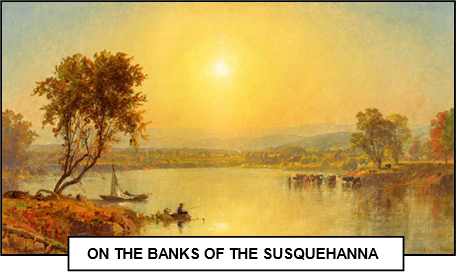
xxxxxHe left university without a degree in 1794, and it was then that, together with the poet Robert Southey, whom he had met by chance, he conjured up the romantic idea of establishing a farming commune in the United States. Moved by the current ideas of liberty and equality (and their current failure in France) the two poets planned a small settlement along the banks of the Susquehanna River in Pennsylvania (Coleridge liked the name !) where they could live in perfect peace and harmony. Perhaps not surprisingly, “Pantisocracy”, as the scheme was called, never got off the ground. Instead, they worked together to produce a verse drama about The Fall of Robespierre, published that year. In 1796 he produced his Poems on Various Subjects, and then the following year he and his family moved to Nether Stowey, Somerset. It was there that he worked on the Lyrical Ballads with Wordsworth, then living with his sister Dorothy in the nearby village of Alfoxden. “We are three people,” Coleridge wrote at the time, “but only one soul”.
xxxxxIn 1798, given an allowance by the brothers Josiah and Thomas Wedgwood, he accompanied William and Dorothy Wordsworth to Germany. Here he attended lectures on physiology at Gottingen, and on returning to England the following year made his first tour of the Lake District. In 1800 events moved in his favour. He was acclaimed for his masterly translation of Schiller’s dramatic trilogy Wallenstein, and employed to write a series of political articles for the Morning Post. It was then that he moved to Greta Hall (illustrated) at Keswick in the Lake District, a move which seriously affected his health. He had suffered from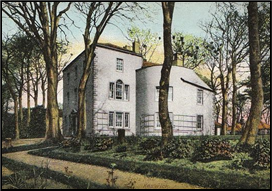 rheumatism since a child, and the damp climate there made his condition worse. He then changed from laudanum to opium to relieve his suffering, and his growing reliance upon this more powerful drug affected his mental state. He became miserable and frustrated, feelings which he eloquently described in his Dejection: An Ode, written in 1802. This proved to be the last of his major poetic works. From then on he concentrated mainly on political writings and literary criticism.
rheumatism since a child, and the damp climate there made his condition worse. He then changed from laudanum to opium to relieve his suffering, and his growing reliance upon this more powerful drug affected his mental state. He became miserable and frustrated, feelings which he eloquently described in his Dejection: An Ode, written in 1802. This proved to be the last of his major poetic works. From then on he concentrated mainly on political writings and literary criticism.
xxxxxIn 1804 he took another trip to Europe, seeking a warmer climate. He travelled first to Malta, where he worked as secretary to the acting governor, and then visited Naples and Rome, but this did nothing to relieve his suffering in body or mind. On returning to England in 1806 he found it difficult to work and, estranged from his wife, moved around the country, alone or with members of his family. Then in 1810 his long friendship with Wordsworth began to break up -
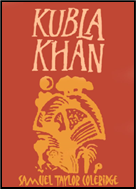 xxxxxIn 1816, his health deteriorating, he moved to London and lived in the house of James Gillman, a doctor in Highgate. Under his care his condition improved, and to this period belongs the publication of Kubla Khan, and the completion of his Biographia Literaria, achieved in 1817. In 1824 he was elected a fellow of the Royal Society of Literature, and this did much to boost his self-
xxxxxIn 1816, his health deteriorating, he moved to London and lived in the house of James Gillman, a doctor in Highgate. Under his care his condition improved, and to this period belongs the publication of Kubla Khan, and the completion of his Biographia Literaria, achieved in 1817. In 1824 he was elected a fellow of the Royal Society of Literature, and this did much to boost his self-
xxxxxAs a poet his place in English literature is secure. In terms of the “height and perfection of imaginative quality”, as the poet Algernon Charles Swinburne later put it, “he is the greatest of lyric poets. This is his special power and this is his special praise”. To this must be added his outstanding ability as a literary critic, and the part he played, along with Wordsworth, in bringing about a veritable revolution in English poetry. As we shall see (1807 G3c), Lyrical Ballads, their joint production of 1798, marked the beginning of the colourful Romantic Movement in English literature.
Acknowledgements
Coleridge: by the Dutch artist Peter Van Dyke (1729-
G3b-

At length did cross an Albatross,
Thorough the fog it came;
As if it had been a Christian soul,
We hailed it in God’s name.
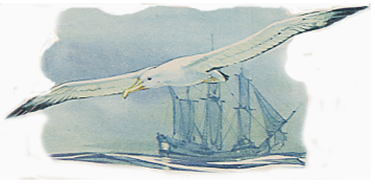
xxxxxThe English poet Robert Southey (1774-
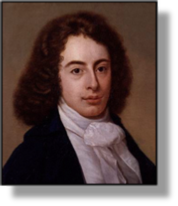 xxxxxSouthey was born in Bristol, son of a linen draper, but for most of his childhood he was brought up by an aunt in Bath. He was educated at Westminster School, London, and then attended Oxford University, leaving without a degree in 1794. After meeting and working with Coleridge, he went to Portugal in 1800 but, on his return, he and his family went to live with the Coleridge family at Greta Hall, Keswick, in 1803 (where he and his wife remained for the rest of their lives). It was because of his close friendship with Coleridge at this time and, later, with William Wordsworth, that his name became closely associated with the early romantic movement and, like them, he came to be known as one of the “Lake Poets”. In fact, however, his poetry contributed little to the movement, and today he is remembered more for his masterly prose -
xxxxxSouthey was born in Bristol, son of a linen draper, but for most of his childhood he was brought up by an aunt in Bath. He was educated at Westminster School, London, and then attended Oxford University, leaving without a degree in 1794. After meeting and working with Coleridge, he went to Portugal in 1800 but, on his return, he and his family went to live with the Coleridge family at Greta Hall, Keswick, in 1803 (where he and his wife remained for the rest of their lives). It was because of his close friendship with Coleridge at this time and, later, with William Wordsworth, that his name became closely associated with the early romantic movement and, like them, he came to be known as one of the “Lake Poets”. In fact, however, his poetry contributed little to the movement, and today he is remembered more for his masterly prose -
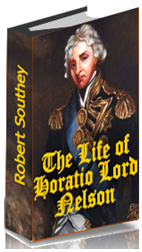
xxxxxIn order to cater for his own large family, and to care for Coleridge’s family when he was away, Southey had to turn his hand to a number of skills, working when so required as a poet, historian, reviewer, translator, and a writer on political affairs. Among his major poetic works are his long epic poems of the early 1800s, Madoc, Thalaba the Destroyer, and The Curse of Kehama. As verse romances these were quite successful in their day, but it is his prose work that has stood the test of time, due mainly to his attractive, lucid style. His historical studies included his Life of Nelson in 1813 -
xxxxxHe gained a good source of income from his political writings, but this attracted criticism from a number of quarters. In 1809, seemingly abandoning his republican views -
xxxxxIn 1813 Southey was made poet laureate, due in large measure to the influence of the novelist Sir Walter Scott (who had refused the honour himself), and this, together with a government pension, made him financially secure. But his latter years were not happy ones. His wife became insane and died in 1837, and quarrels broke out in his family over his second marriage. He himself became mentally ill towards the end of his life, and died at Keswick in March 1843. There is a memorial to him in Crosthwaite Church, where he was buried

xxxxxIncidentally, his work of fiction entitled The Doctor, which ran to seven volumes, and was a hotchpotch of quotations, observations and short stories, included his version of the well-
xxxxxThe English poet Robert Southey (1774-
xxxxxIncidentally, the story of the Ancient Mariner may well have been inspired by the voyage of an English navigator called Thomas James (1593-


